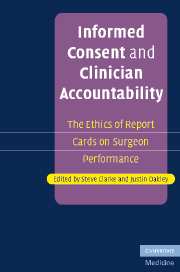Book contents
- Frontmatter
- Contents
- List of contributors
- Acknowledgements
- Introduction: Accountability, informed consent and clinician performance information
- Part I Accountability
- Part introduction
- 1 Clinician report cards and the limits of evidence-based patient choice
- 2 Report cards for institutions, not individuals
- 3 Safety, accountability, and ‘choice’ after the Bristol Inquiry
- 4 Public reports: putting patients in the picture requires a new relationship between doctors and patients
- 5 Adverse event disclosure: benefits and drawbacks for patients and clinicians
- 6 Report cards and performance monitoring
- Part II Informed consent
- Part III Reporting performance information
- Index
- References
5 - Adverse event disclosure: benefits and drawbacks for patients and clinicians
Published online by Cambridge University Press: 08 August 2009
- Frontmatter
- Contents
- List of contributors
- Acknowledgements
- Introduction: Accountability, informed consent and clinician performance information
- Part I Accountability
- Part introduction
- 1 Clinician report cards and the limits of evidence-based patient choice
- 2 Report cards for institutions, not individuals
- 3 Safety, accountability, and ‘choice’ after the Bristol Inquiry
- 4 Public reports: putting patients in the picture requires a new relationship between doctors and patients
- 5 Adverse event disclosure: benefits and drawbacks for patients and clinicians
- 6 Report cards and performance monitoring
- Part II Informed consent
- Part III Reporting performance information
- Index
- References
Summary
Introduction
Since the Institute of Medicine (1999) published To Err is Human in 1999, many publications have discussed the need for different approaches to disclosing adverse events to patients, and the need to create a culture of safety within the healthcare system. Many of these articles begin with a clinician discussing an adverse event in which they were involved (Richards, 2000; Wu, 2001; Payne, 2002). Each individual story provides the medical and policy communities with an isolated view of an adverse event and the disclosure or non-disclosure of that event to the patient. There have also been research papers in the legal and medical literature that are designed to address specific areas of disclosure (Popp, 2003; Wu, 2000). Error disclosure is now required by ethicists, professional organizations and increasingly by regulatory bodies.
The goal of this chapter is to combine these accounts, stories and recommendations into a coherent roadmap for guidance in the field of disclosure. To accomplish this goal, we will begin by defining key terms, and will provide evidence that disclosure is a central part of fostering a safety culture. We will examine physician report cards and their relationship to disclosure policies. We will address the significant gap that exists between the principle of error disclosure and actual practice. Although most of the literature on disclosure is based on in-patient adverse event occurrences, most of healthcare occurs in the ambulatory setting.
- Type
- Chapter
- Information
- Informed Consent and Clinician AccountabilityThe Ethics of Report Cards on Surgeon Performance, pp. 76 - 90Publisher: Cambridge University PressPrint publication year: 2007
References
- 5
- Cited by



